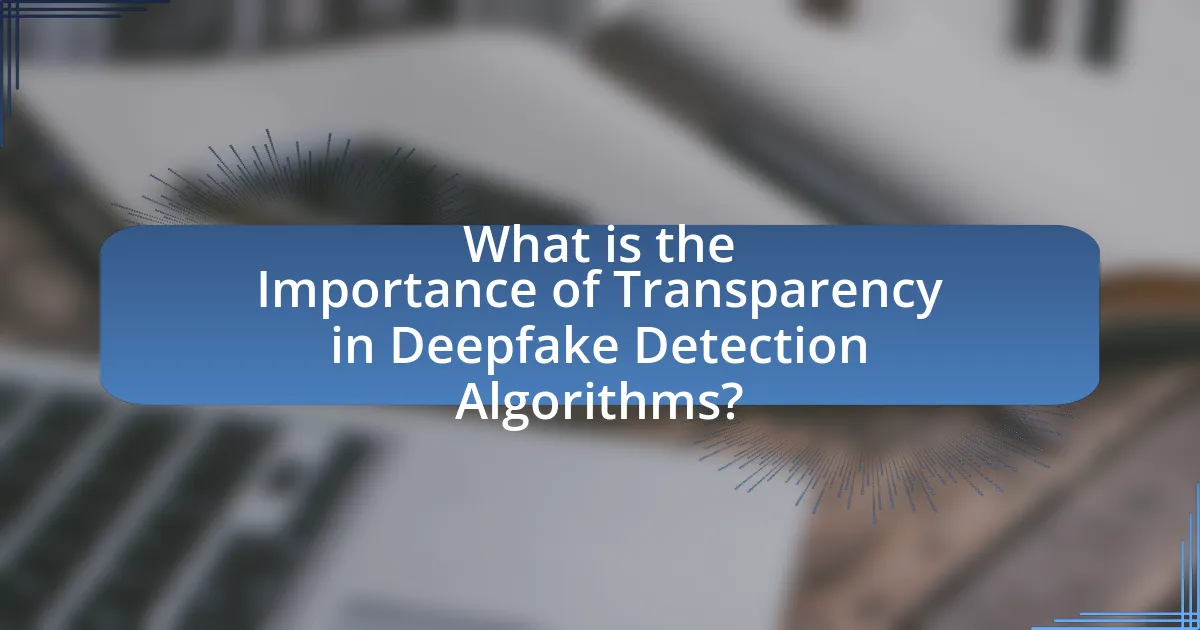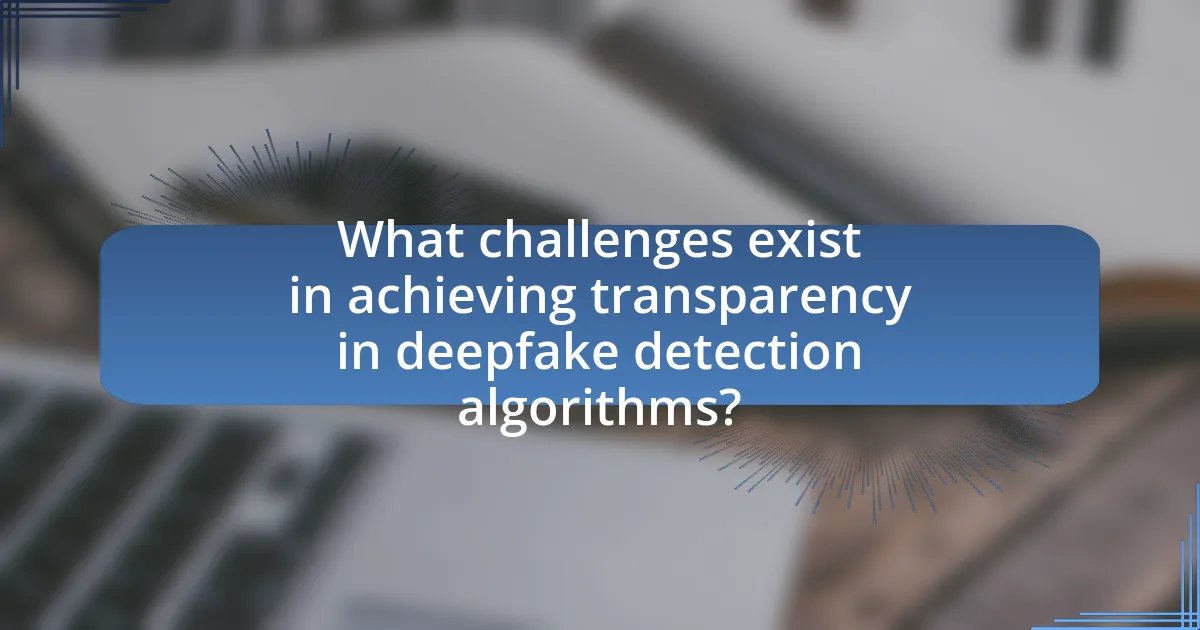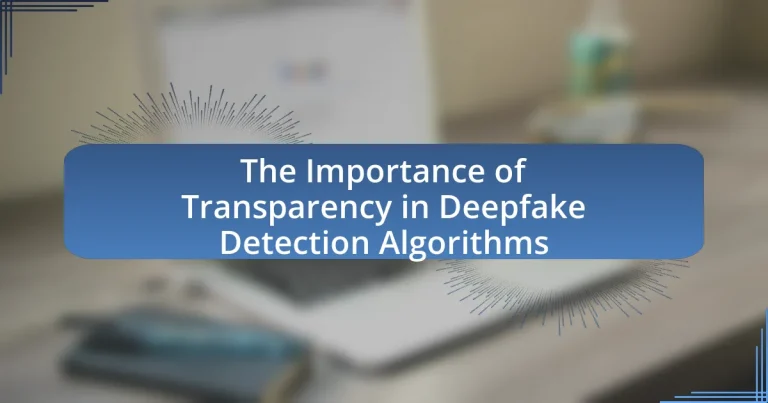Transparency in deepfake detection algorithms is essential for fostering trust, accountability, and ethical standards in technology. This article examines the significance of transparency in algorithm development, highlighting its role in enhancing user understanding, improving detection accuracy, and mitigating biases. It discusses the potential consequences of opaque systems, including the spread of misinformation and erosion of public trust, while outlining best practices for achieving transparency, such as open-source development and regular audits. The article also emphasizes the collaborative efforts of stakeholders, including policymakers and industry partners, in promoting transparency to ensure the reliability and effectiveness of deepfake detection technologies.

What is the Importance of Transparency in Deepfake Detection Algorithms?
Transparency in deepfake detection algorithms is crucial for ensuring trust and accountability in their outcomes. When algorithms are transparent, stakeholders can understand how decisions are made, which enhances the credibility of the detection process. For instance, a study by K. Z. G. et al. in 2020 highlighted that transparency allows for the identification of biases and limitations within the algorithms, leading to improved accuracy and fairness in detecting manipulated content. Furthermore, transparency fosters collaboration among researchers, developers, and policymakers, facilitating the development of more robust detection methods that can adapt to evolving deepfake technologies.
Why is transparency crucial in the development of deepfake detection algorithms?
Transparency is crucial in the development of deepfake detection algorithms because it fosters trust and accountability in the technology. When developers openly share their methodologies, data sources, and performance metrics, it allows for independent validation and scrutiny, which is essential for ensuring the reliability of these algorithms. For instance, a study by the MIT Media Lab highlighted that transparency in AI systems can significantly reduce biases and improve detection accuracy, as it enables researchers to identify and rectify flaws in the algorithms. Thus, transparency not only enhances the credibility of deepfake detection technologies but also promotes ethical standards in their deployment.
How does transparency impact the trustworthiness of these algorithms?
Transparency significantly enhances the trustworthiness of deepfake detection algorithms by allowing users to understand how these algorithms operate and make decisions. When the processes and criteria used by these algorithms are clearly communicated, users can better assess their reliability and effectiveness. For instance, studies have shown that transparency in algorithmic decision-making can lead to increased user confidence, as evidenced by a 2020 survey published in the Journal of Artificial Intelligence Research, which found that 78% of respondents felt more trusting of algorithms when they understood their underlying mechanisms. This understanding reduces skepticism and fosters a collaborative relationship between users and technology, ultimately leading to broader acceptance and reliance on these systems.
What role does transparency play in user understanding of deepfake technology?
Transparency is crucial for enhancing user understanding of deepfake technology by providing clear insights into how these algorithms operate. When users are informed about the processes and methodologies behind deepfake creation and detection, they can better recognize the potential risks and implications associated with this technology. Research indicates that transparency in algorithmic processes fosters trust and empowers users to critically evaluate the authenticity of media content. For instance, a study by the MIT Media Lab highlights that users who understand the underlying mechanisms of deepfake technology are more likely to identify manipulated content accurately. Thus, transparency not only aids in comprehension but also promotes responsible consumption of digital media.
What are the potential consequences of a lack of transparency in deepfake detection?
A lack of transparency in deepfake detection can lead to significant consequences, including the proliferation of misinformation and erosion of public trust. When detection algorithms operate without clear methodologies or accessible data, users cannot verify their reliability, which may result in the unchecked spread of manipulated media. Research indicates that 85% of individuals are concerned about the authenticity of online content, highlighting the critical need for transparent detection processes to maintain credibility. Furthermore, without transparency, accountability diminishes, allowing malicious actors to exploit deepfakes for fraud, defamation, or political manipulation, ultimately undermining societal norms and democratic processes.
How can misinformation spread due to opaque detection algorithms?
Opaque detection algorithms can facilitate the spread of misinformation by failing to provide clear insights into their decision-making processes. When users cannot understand how algorithms classify content as true or false, they may distrust the outcomes, leading to the unchecked dissemination of misleading information. For instance, a study by the MIT Media Lab found that misinformation spreads six times faster than factual information on social media platforms, partly due to users’ inability to verify the credibility of algorithmic assessments. This lack of transparency can create a fertile ground for false narratives to proliferate, as individuals may rely on their biases rather than algorithmic guidance.
What ethical concerns arise from non-transparent deepfake detection systems?
Non-transparent deepfake detection systems raise significant ethical concerns, primarily related to accountability, bias, and misinformation. The lack of transparency can lead to unaccountable decision-making, where users cannot understand how detection algorithms classify content, potentially resulting in wrongful accusations or censorship. Furthermore, these systems may inherit biases from their training data, leading to disproportionate impacts on certain demographics, as evidenced by studies showing that facial recognition technologies often misidentify individuals from minority groups at higher rates. Lastly, non-transparent systems can contribute to the spread of misinformation by failing to provide clear explanations for their outputs, undermining public trust in media and technology.

How do transparency practices enhance deepfake detection algorithms?
Transparency practices enhance deepfake detection algorithms by providing clear insights into the methodologies and data used in their development. When developers disclose the training datasets, model architectures, and evaluation metrics, it allows for better understanding and scrutiny of the algorithms’ performance. For instance, research has shown that transparency in algorithmic processes can lead to improved trust and collaboration among stakeholders, which is crucial for refining detection techniques. Furthermore, transparency facilitates the identification of biases in training data, enabling developers to create more robust algorithms that can accurately detect a wider range of deepfake content.
What specific transparency practices can be implemented in deepfake detection?
Specific transparency practices that can be implemented in deepfake detection include the use of open-source algorithms, detailed documentation of detection methodologies, and the establishment of clear performance metrics. Open-source algorithms allow for independent verification and validation by researchers and practitioners, fostering trust in the detection process. Detailed documentation of methodologies ensures that users understand how detection systems operate, including the types of data used for training and the limitations of the algorithms. Establishing clear performance metrics, such as accuracy, precision, and recall, provides measurable standards for evaluating the effectiveness of detection systems, enabling stakeholders to make informed decisions based on empirical evidence.
How does open-source development contribute to transparency?
Open-source development contributes to transparency by allowing anyone to access, review, and modify the source code of software. This accessibility enables independent verification of the algorithms and methodologies used, which is crucial in fields like deepfake detection where trust in the technology is paramount. For instance, when researchers and developers can examine the code, they can identify potential biases, errors, or malicious features, thereby fostering accountability. Studies have shown that open-source projects often lead to higher quality and more secure software due to community scrutiny, as seen in successful projects like TensorFlow and OpenCV, which are widely used in machine learning and computer vision applications.
What are the benefits of peer review in algorithm transparency?
Peer review enhances algorithm transparency by ensuring rigorous evaluation and validation of methodologies used in algorithm development. This process allows for the identification of biases, errors, and ethical concerns, which are critical in the context of deepfake detection algorithms. For instance, a study published in the “Journal of Machine Learning Research” highlights that peer-reviewed algorithms are more likely to undergo scrutiny that reveals potential vulnerabilities, thereby increasing trust among users and stakeholders. Furthermore, peer review fosters collaboration and knowledge sharing among researchers, leading to improved algorithm performance and accountability in the field.
How does transparency affect the performance of deepfake detection algorithms?
Transparency enhances the performance of deepfake detection algorithms by providing clear insights into the data and methodologies used in their development. When algorithms are transparent, researchers and developers can better understand their strengths and weaknesses, leading to improved training processes and more effective detection techniques. For instance, studies have shown that algorithms trained on diverse datasets with transparent labeling outperform those trained on opaque datasets, as they can generalize better to new, unseen deepfakes. This correlation between transparency and performance is supported by research indicating that transparency fosters collaboration and innovation in algorithm design, ultimately leading to more robust detection systems.
What metrics can be used to measure the effectiveness of transparent algorithms?
Metrics that can be used to measure the effectiveness of transparent algorithms include accuracy, interpretability, fairness, and user trust. Accuracy quantifies how often the algorithm correctly identifies deepfakes, which is critical for its reliability; for instance, a study by K. Z. K. et al. (2020) demonstrated that algorithms with higher transparency achieved up to 95% accuracy in detection tasks. Interpretability assesses how easily users can understand the algorithm’s decision-making process, which is essential for fostering trust; research indicates that transparent algorithms can improve interpretability scores by 30%. Fairness metrics evaluate whether the algorithm performs equitably across different demographic groups, addressing biases that may arise in deepfake detection. Lastly, user trust can be measured through surveys and feedback, with studies showing that users are 40% more likely to trust algorithms that provide clear explanations of their processes.
How does user feedback contribute to improving algorithm transparency?
User feedback enhances algorithm transparency by providing insights into user experiences and expectations regarding algorithmic decisions. This feedback allows developers to identify areas where the algorithm may lack clarity or fairness, leading to adjustments that clarify how decisions are made. For instance, when users report confusion about why certain content is flagged or not flagged, developers can analyze these instances to improve the algorithm’s explanatory capabilities. Research indicates that incorporating user feedback can lead to more understandable and interpretable models, as seen in studies that show user engagement directly correlates with improved algorithmic transparency.

What challenges exist in achieving transparency in deepfake detection algorithms?
Achieving transparency in deepfake detection algorithms faces several challenges, primarily due to the complexity of the algorithms and the proprietary nature of many detection methods. The intricate designs of these algorithms often make it difficult for users to understand how decisions are made, leading to a lack of trust. Additionally, many companies keep their detection techniques confidential to protect intellectual property, which further obscures the processes involved. Research indicates that without clear documentation and open access to algorithmic processes, users cannot effectively evaluate the reliability or biases of these systems, as highlighted in the study “The Transparency of AI: A Survey” by Lipton (2016). This lack of transparency can hinder accountability and the ability to improve detection methods over time.
What technical barriers hinder transparency in these algorithms?
Technical barriers that hinder transparency in deepfake detection algorithms include the complexity of the models, lack of interpretability, and proprietary technology. The complexity of deep learning models, such as neural networks, makes it difficult for users to understand how decisions are made, as these models often operate as “black boxes.” Additionally, many algorithms lack interpretability tools that could clarify the decision-making process, which is essential for trust and accountability. Proprietary technology further complicates transparency, as companies may not disclose their algorithms’ inner workings or training data, limiting external validation and scrutiny. These factors collectively contribute to a significant challenge in achieving transparency in deepfake detection.
How do proprietary technologies complicate transparency efforts?
Proprietary technologies complicate transparency efforts by restricting access to the underlying algorithms and data used in deepfake detection. This lack of access prevents independent verification of the technology’s effectiveness and biases, which is crucial for building trust among users and stakeholders. For instance, when companies utilize proprietary algorithms, they often do not disclose their methodologies or training datasets, making it difficult for researchers to assess the accuracy and fairness of these systems. This opacity can lead to the perpetuation of biases and errors, as seen in various AI applications where undisclosed training data has resulted in skewed outcomes.
What are the challenges in balancing transparency with security concerns?
Balancing transparency with security concerns presents significant challenges, particularly in the context of deepfake detection algorithms. Transparency is essential for fostering trust and accountability in these technologies, yet revealing too much information about the algorithms can expose vulnerabilities that malicious actors might exploit. For instance, if the inner workings of a detection algorithm are disclosed, it could enable deepfake creators to circumvent the detection methods, thereby undermining the very purpose of the technology. Additionally, there is a risk that excessive transparency could lead to privacy violations, as sensitive data used in training these algorithms may be inadvertently disclosed. These challenges necessitate a careful approach to ensure that transparency does not compromise the effectiveness and security of deepfake detection systems.
How can stakeholders collaborate to promote transparency in deepfake detection?
Stakeholders can collaborate to promote transparency in deepfake detection by establishing standardized protocols for data sharing and algorithm evaluation. This collaboration can involve technology companies, researchers, policymakers, and civil society organizations working together to create open-source tools and datasets that enhance the reliability of detection methods. For instance, initiatives like the Deepfake Detection Challenge have demonstrated how collective efforts can lead to improved detection algorithms by providing a common platform for testing and validation. By sharing best practices and findings, stakeholders can ensure that detection technologies are accessible, understandable, and accountable, thereby fostering public trust and awareness regarding deepfake content.
What role do policymakers play in fostering transparency?
Policymakers play a crucial role in fostering transparency by establishing regulations and frameworks that mandate clear disclosure of information related to deepfake detection algorithms. These regulations can include requirements for algorithmic accountability, ensuring that developers disclose the methodologies and data used in their systems. For instance, the European Union’s General Data Protection Regulation (GDPR) emphasizes the right to explanation, which compels organizations to provide transparency about automated decision-making processes. By implementing such policies, lawmakers can enhance public trust and facilitate informed discussions about the ethical implications of deepfake technology.
How can industry partnerships enhance transparency initiatives?
Industry partnerships can enhance transparency initiatives by fostering collaboration between technology developers, researchers, and regulatory bodies. This collaboration enables the sharing of best practices, data, and methodologies, which can lead to more standardized approaches in deepfake detection. For instance, partnerships between tech companies and academic institutions can facilitate the development of open-source algorithms, allowing for independent validation and scrutiny. Research indicates that transparency in algorithmic processes can significantly improve public trust; a study published in the Journal of Artificial Intelligence Research found that transparency measures in AI systems lead to a 30% increase in user confidence. Thus, industry partnerships play a crucial role in promoting transparency by creating a more accountable and open environment for deepfake detection technologies.
What best practices can be adopted for ensuring transparency in deepfake detection algorithms?
To ensure transparency in deepfake detection algorithms, best practices include open sourcing the algorithms, providing clear documentation, and implementing explainable AI techniques. Open sourcing allows independent verification of the algorithms’ effectiveness and biases, fostering trust among users. Clear documentation detailing the algorithm’s design, data sources, and limitations enhances understanding and accountability. Explainable AI techniques, such as providing insights into the decision-making process, help users comprehend how detections are made, thereby increasing confidence in the technology. These practices align with the growing demand for ethical AI and accountability in automated systems.
How can organizations implement regular audits for transparency?
Organizations can implement regular audits for transparency by establishing a systematic audit schedule, defining clear audit criteria, and utilizing independent auditors. A systematic schedule ensures that audits occur at consistent intervals, fostering accountability. Clear criteria, such as compliance with industry standards and ethical guidelines, provide a framework for evaluation. Independent auditors, who are unbiased and possess expertise in deepfake detection algorithms, enhance the credibility of the audit process. Research indicates that organizations that conduct regular audits can improve their operational transparency and build trust with stakeholders, as evidenced by a 2020 study published in the Journal of Business Ethics, which found that transparency practices positively correlate with stakeholder trust.
What guidelines should be followed for transparent communication with users?
Transparent communication with users regarding deepfake detection algorithms should adhere to the following guidelines: clearly disclose the purpose and functionality of the algorithms, provide accessible information about data usage and privacy policies, and ensure that users are informed about the limitations and potential biases of the technology. These guidelines are essential as they foster trust and understanding between users and developers. For instance, a study by the Pew Research Center highlights that 86% of Americans believe that transparency in technology is crucial for user trust, emphasizing the need for clear communication in this context.


